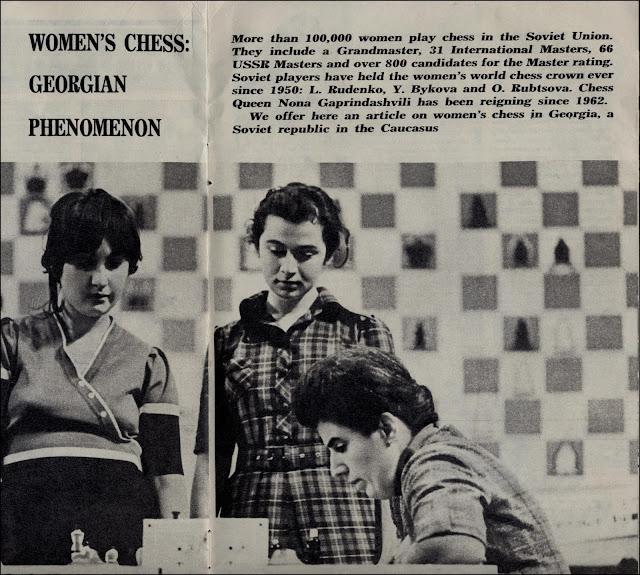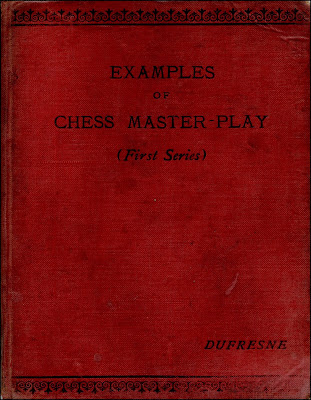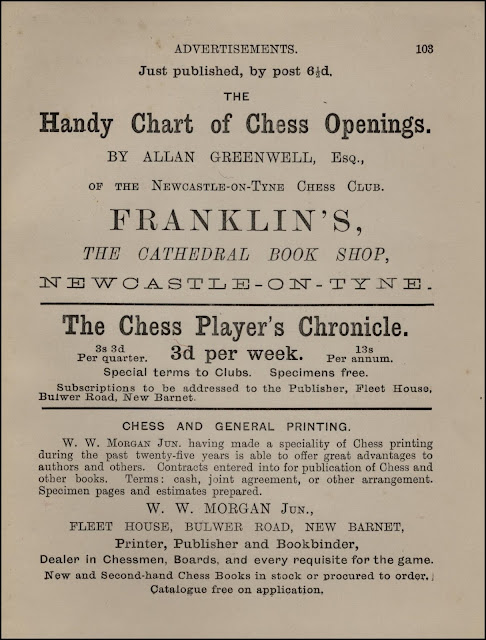Biblio, the short lived American magazine was "a brave attempt to create a quality international magazine for book collectors" and it was certainly an impressive production. The magazine was published between August 1996 and April 1999.
The May 1998 issue included a scholarly eight page article: Kingly Books of a Royal Game, by James Weinheimer, a chess historian and librarian at Princeton University, and Angus Carroll, a collector of rare books from Chicago.
The article opens with the line "Long before chess had black and white squares it had a chequered past" and relates a few old anecdotes featuring King Knut, the Byzantine Emperor Nicephorus I, King Ferdinand of Spain and Christopher Columbus.
The authors interweave chess history with the literatature of the game and they focus on three great American chess collections formed during the latter part of the nineteenth century; those of John G. White of Cleveland, Charles Gilberg of Brooklyn, New York, and Eugene B. Cook of Hoboken, New Jersey. All three collections were ultimately bequethed to major American research libraries.
The John G. White Collection.
Noting that this is the largest collection of chess books in the world with more than 35,000 volumes, the authors give details of some of the very earliest books in the collection including the first printed book that refers to chess, Summa Collationum by John of Wales, Cologne 1470; Caxton's morality, The Game and Playe of the Chesse, Bruges c1475, (the collection also holds nine manuscript copies of De Ludo Scacchorum by Jacobus de Cessolis from the 13th and 14th centuries, one copy of which contains the only known portrait of the author); and the third printed book on chess (excluding the moralities of John of Wales and Caxton), Questo Libro e da Imparare Giocare à Scachi et de le Partite, by Damiano, Rome 1512.
Regarding the latter work the authors observe "since most books of the time were unillustrated, this book's woodcut illustrations made for difficult printing, and the printers of the various editions traded the blocks among themselves. Consequently, the different editions can be dated by examining the deterioration of the woodcuts."
Other noteworthy items in the collection include Il Dilettevole e Giudizioso Giuoco de Scacchi, Venice 1724 - 1735, which includes 49 hand drawn plates demonstrating the basic rules of the game, and Thomas Middleton's satirical and allegorical play A Game at Chess, London 1625. The play was shut down after only nine days on the orders of King James I following complaints from the Spanish ambassador to Great Britain who believed that he had been portrayed unfavourably in the play .
The Charles Gilberg Collection.
New York businessman and noted problemist, Charles Gilberg, built a major chess collection with an emphasis on fine bindings. After his death in 1898 Gilberg's heirs kept the collection until 1930 when it was sold to Silas W. Howland, who willed the 2,800 volumes to Harvard University.
The collection includes a first edition of Ruy Lopez's work Libro de la Invencion Liberal y Arte del Juego del Axedrez, Alcala 1561, written partly in criticism of Damiano's treatise.
The Biblio authors discuss the earliest original chess book in English, Arthur Saul's The Famous Game of Chesse-Play, London 1614, noting that this was aimed at the nobilty, being "fit for princes or any person of quality soever", and commenting on Saul's curious classification of checkmates.
Thomas Hyde, professor of Arabic and Hebrew at Oxford Univerity and chief librarian at the Bodleian Library, authored the first scholarly history of chess, Mandragorias seu Historia Shahiludii, Oxford 1694, however, the authors claim that the title reflects a mistake. "Hyde had followed an incorrect etymology for the Arabic word for chess, using satrang instead of shatranj, then translating satrang into Latin: Mandragorias, which actually means mandrake root."
"Nevertheless, the book's many languages displayed both Professor Hyde's erudition and the wide typograpical resources of the Oxford press 300 years ago. This book represents its era's state of the art in printing."
The E. B. Cook Collection
Eugene Beauharnais Cook formed the third of the great American chess collections, he nurtured a deep interest in chess history and bibliography, and when he died in 1915 the collection of 3,000 items was bequethed to Princeton University Library.
The Cook collection includes one of the earliest books to expose the workings of Wolfgang von Kempelen's automaton, the Turk: Ueber den Schachspieler des Kempelen und dessen Nachbildung, by Joseph Racknitz, Leipzig/Dresden 1789. The authors give a brief history of the Turk stating that following von Kempelen's death, the machine was purchased by Johann Maelzel in partnership with Ludwig van Beethoven, and then later sold to Napoleon's stepson, Prince Eugene de Beauharnais, after whom E. B. Cook was named.
E. B. Cook's library included the first chess treatise printed in German; Das Schach-oder König-Spiel by Gustav Selenus, i.e. August, Duke of Braunschweig-Luneberg, Lipsiae 1616. This work is a "German translation of Ruy Lopez but with a unique notation that limited the book's appeal.... However it is a favourite of collectors because of the dozens of extraordinary plates and engravings."
E. B. Cook was the judge for the problem tournament at the First American Chess Congress of 1857 and his collection obviously included The Book of the First American Chess Congress, by Willard Fiske, New York 1859. The authors state that this is useful for its history of chess in early America and complete bibliography of American chess books. However, the bibliography had several omissions as noted by Ralph Hagedorn in Benjamin Franklin and Chess in Early America, Philadelphia 1958, which lists 60 books published up to 1859 compared with 39 in Fiske's work.
The authors reveal that the Cook collection proudly housed one of only ten copies of the earliest surviving printed treatises on chess, Repetición de Amores e Arte de Axedrez, by Luis Ramirez de Lucena, Salamanca 1497, explaining that the only known copy of the first printed chess treatise, Libre dels Jochs Partitis dels Schachs en Nombre de 100, by Francesch Vicent, Valencia 1495, was lost in 1811, during the French occupation of Montserrat, where the book was kept in a Benedictine monastery. They were unaware, twenty years ago, of the sensational discovery of the Cesena manuscript , which includes Vicent's work, as detailed in The Return of Francesch Vicent, by Jose A. Garcon, Valencia 2005.
Lucena's work is in two parts; an anti-feminist tract and a chess treatise. Princeton's copy contains only the chess section which describes both the older and newer versions of the game.
In the final part of the article, sub-titled To Err is Human, the authors make some very pertinent, (and reassuring), remarks on the future of chess in the computer age; these are particularly apposite in the light of Alpha Zero's recent exploits. Deep Blue had just defeated Kasparov in 1997, following which some commentators had proclaimed the end of chess as we know it.
The authors respond "This is nonsense, chess is not about making 200 million calculations per second, it is about psychology and strategy, vision and risk, flashes of brilliance amongst the darkness of uncertainty.... No computer is on the verge of creating masterpieces such as the games of Capablanca, Alekhine or Tal, because genius is not the product of blind calculation."
"The world can do without My Best Games, by Deep Blue, which might include; First I mindlessly calculated eight billion moves, then, without knowing whom I was playing, or even why, I calculated a few billion more."
Although computers may one day play the perfect game, this will not matter, since, a computer might calculate umpteen gazillion moves without making a single error, but no human ever will. "The Royal Game will continue to be played for the same reason it always has been, because chess is one of the most challenging and rewarding of all intellectual endeavours. The machines will play their one game of chess among themselves, but, for us, there will always be crushing defeats and miraculous escapes, electrifying sacrifices and terrible blunders. The very imperfection of human play being the source of the game's infinite beauty. And undoubtedly more great books on chess will come....."
The article concludes with some diverse recommendations for A Bookshelf fit for a Grand Master:
E. B. Cook was the judge for the problem tournament at the First American Chess Congress of 1857 and his collection obviously included The Book of the First American Chess Congress, by Willard Fiske, New York 1859. The authors state that this is useful for its history of chess in early America and complete bibliography of American chess books. However, the bibliography had several omissions as noted by Ralph Hagedorn in Benjamin Franklin and Chess in Early America, Philadelphia 1958, which lists 60 books published up to 1859 compared with 39 in Fiske's work.
The authors reveal that the Cook collection proudly housed one of only ten copies of the earliest surviving printed treatises on chess, Repetición de Amores e Arte de Axedrez, by Luis Ramirez de Lucena, Salamanca 1497, explaining that the only known copy of the first printed chess treatise, Libre dels Jochs Partitis dels Schachs en Nombre de 100, by Francesch Vicent, Valencia 1495, was lost in 1811, during the French occupation of Montserrat, where the book was kept in a Benedictine monastery. They were unaware, twenty years ago, of the sensational discovery of the Cesena manuscript , which includes Vicent's work, as detailed in The Return of Francesch Vicent, by Jose A. Garcon, Valencia 2005.
Lucena's work is in two parts; an anti-feminist tract and a chess treatise. Princeton's copy contains only the chess section which describes both the older and newer versions of the game.
In the final part of the article, sub-titled To Err is Human, the authors make some very pertinent, (and reassuring), remarks on the future of chess in the computer age; these are particularly apposite in the light of Alpha Zero's recent exploits. Deep Blue had just defeated Kasparov in 1997, following which some commentators had proclaimed the end of chess as we know it.
The authors respond "This is nonsense, chess is not about making 200 million calculations per second, it is about psychology and strategy, vision and risk, flashes of brilliance amongst the darkness of uncertainty.... No computer is on the verge of creating masterpieces such as the games of Capablanca, Alekhine or Tal, because genius is not the product of blind calculation."
"The world can do without My Best Games, by Deep Blue, which might include; First I mindlessly calculated eight billion moves, then, without knowing whom I was playing, or even why, I calculated a few billion more."
Although computers may one day play the perfect game, this will not matter, since, a computer might calculate umpteen gazillion moves without making a single error, but no human ever will. "The Royal Game will continue to be played for the same reason it always has been, because chess is one of the most challenging and rewarding of all intellectual endeavours. The machines will play their one game of chess among themselves, but, for us, there will always be crushing defeats and miraculous escapes, electrifying sacrifices and terrible blunders. The very imperfection of human play being the source of the game's infinite beauty. And undoubtedly more great books on chess will come....."
The article concludes with some diverse recommendations for A Bookshelf fit for a Grand Master:



























































